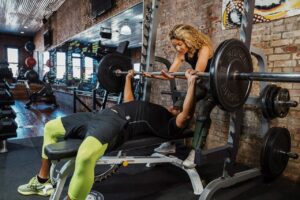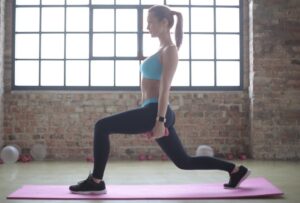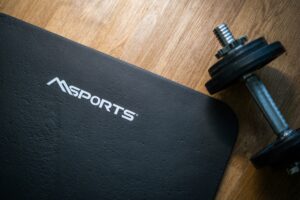The Benefits of Barbell Back Workouts
If your goals are to build muscle, raw strength, power, and overall athleticism, you don’t need to look any further than the barbell. All barbell back movements train a range of muscles, which means you can have quicker and more efficient workouts. For example, the bent-over barbell row is a back exercise. But few people consider how big of an effect this movement truly has on us. The barbell row trains the back (1). But the exercise also works our grip, forearms, biceps, and shoulders.
What makes the barbell such a good piece of equipment for back training? One reason is that the back is a complex muscle group composed of many moving parts (2). You have your lats, traps, and rhomboids – the better-known muscles. But you also have the erector spinae, teres major and minor, and infraspinatus.
Developing all of these muscles is what leads to a thick, dense, and wide-looking back. If you don’t believe me, just take a look at any strength athlete who can deadlift or barbell row several hundred pounds of weight. They’ll be sure to have remarkable back development. Plus, look at barbell routines like the 5×5 workout. You only get to do five movements, but the results you can achieve are awe-inspiring.
How to get strong back muscles using a barbell?
Having a strong back is essential for your athletic performance, strength output, and general well-being. Most notably, a strong back provides a resilient base for many exercises, including bench and overhead pressing.
Your back is also essential for your ability to brace well and remain stable, especially while lifting heavy weights (3). For example, your back plays a critical role in your ability to keep you steady while squatting heavyweights. And of course, we can’t forget that strong back muscles allow us to row more weight, deadlift better, and do more pull-ups. Beyond that, your back is essential for your well-being and everyday life. For one, strong back muscles allow you to maintain good posture and keep shoulder and neck aches at bay (4). Your back also makes you better able to do manual chores, carry groceries, pick your kids up, and much more.
Keep workouts consistent and track your progress with the Hevy – Workout Tracker.
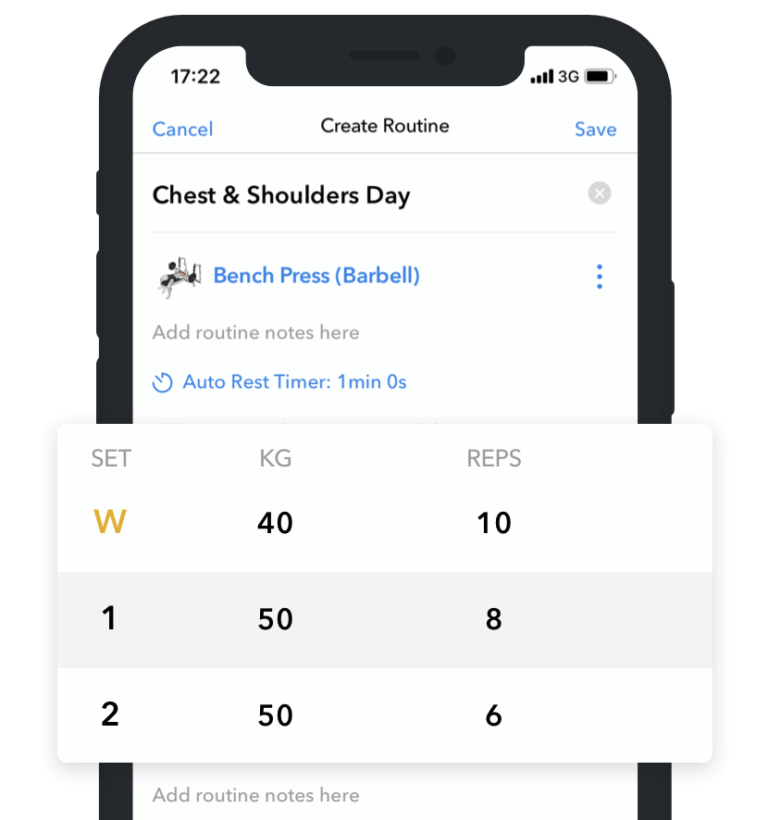
Hevy – Workout Tracker





Hevy – Workout Tracker
Create your own dumbbell back workout with Hevy, and track your progress – for free
As far as proper training goes, your back benefits from two things: good form and a mind-muscle connection. First, good technique is about training with a full range of motion, controlling the weight at all times, and avoiding using momentum as much as you can. Second, an excellent mind-muscle connection often comes with practice. A helpful cue would be to row the weight through your elbow. In other words, think of your hands as mere hooks for the weight. As you row, focus on your back muscles and imagine that they are doing all of the work.
The great news is that using a barbell for your back and bicep training is fantastic, regardless if you’re new to training or have been hitting the gym for a decade. There are many great exercises to pick from, plenty of variations, and a significant overloading potential (5).
Back Workouts for a Strong Back
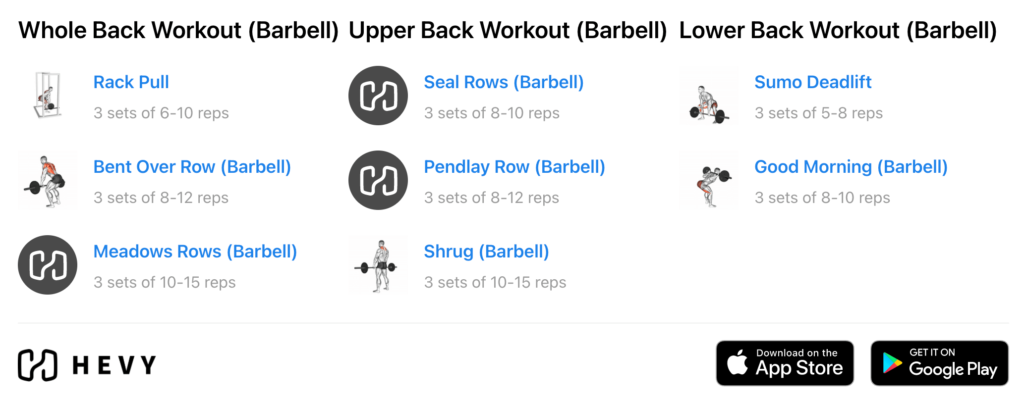

Workout 1: Barbell Whole-back Workout
This first workout will fry your entire back. The first movement trains the back primarily through a hip hinge pattern, where movements two and three greatly emphasize the lats and contribute to a broad back. This workout is an excellent example of what you can include in a weekly push/pull/legs set-up.
- Rack Pull Deadlift – 3 sets of 6 to 10 reps
- Bent-Over Barbell Row – 3 sets of 8 to 12 reps
- Meadow Rows – 3 sets of 10 to 15 reps
Workout 2: Barbell Upper Back Workout
It’s difficult to isolate the upper back with barbell exercises, but this workout comes close to that. Each of the three movements primarily works the upper portion – the rhomboids, rear deltoids, lats, and trapezius. Some lower back involvement is inevitable, but it’s minimal at best.
- Seal Rows – 3 sets of 8 to 10 reps
- Pendlay Rows – 3 sets of 8 to 12 reps
- Barbell Shrugs – 3 sets of 10 to 15 reps
Workout 3: Barbell Lower Back Workout
In contrast to workout 2, this routine is designed to reduce the involvement of the upper back and force the lower portion to do all of the work. For this one, we’ve only chosen two movements because that’s all most people need. Once you get through a few heavy sets on each exercise, you’ll be exhausted. Both movements also train your legs well – particularly your hamstrings and glutes.
- Sumo Deadlift – 3 sets of 5 to 8 reps
- Goodmorning – 3 sets of 8 to 10 reps
The 9 Best Barbell Back Exercises
Exercise 1: Conventional Deadlift
The conventional deadlift is an excellent movement for building a strong posterior chain – everything from your hamstrings to your neck (6). As such, deadlifts are great for using in full-body splits.
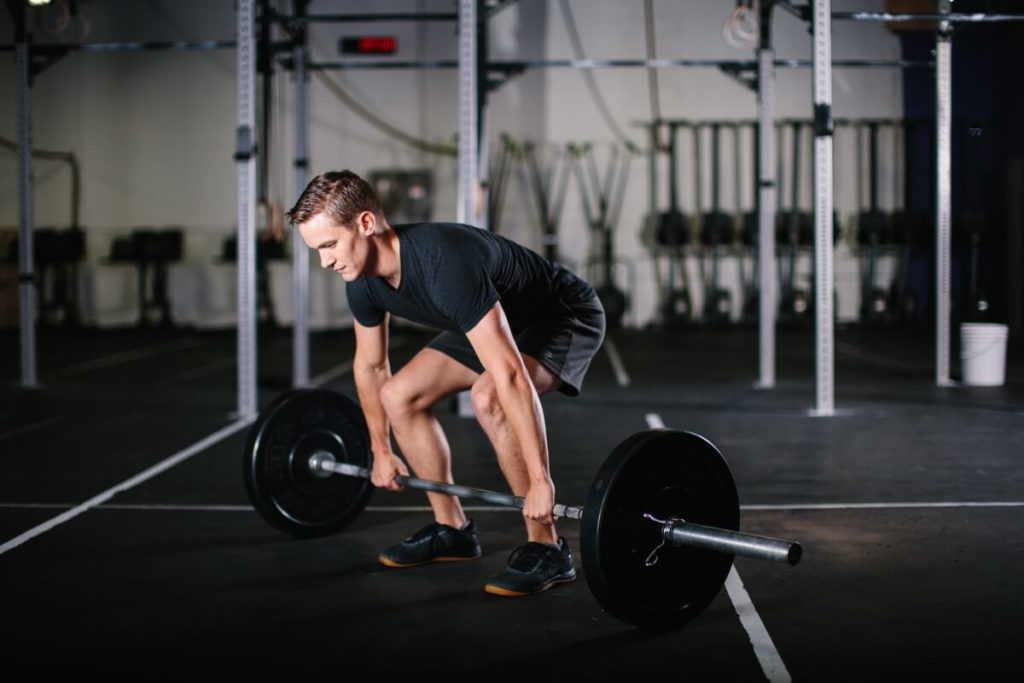

Muscle groups: Hamstrings, Quadriceps, Glutes, Entire Back, Shoulders, Chest, Biceps, Forearms, Abs, and Transverse Abdominis
Equipment: Barbell and Weight Plates
Related Article: 12 of the Best Lower Body Pull Exercises for Strength
Step by Step Instructions:
- Stand over the barbell with your shins a couple of inches away. The bar should appear to be splitting your feet in half when you look down.
- Have your feet hip-width apart with toes pointed slightly out.
- Bend forward and grab the bar with an even, overhand grip. Your hands should be shoulder-width apart.
- Bend your knees and bring your chest out. The maneuver will straighten your back, drive your shins into the barbell, pull the slack, and set you into a strong position. Take a breath.
- Dig your heels into the floor and pull the weight in a straight vertical line.
- As the barbell goes up, extend your knees and hips simultaneously.
- Hold the top position for a moment and lower the barbell in reverse order while keeping it in a straight line downward.
Exercise 2: Bent-Over Barbell Row
The bent-over row is great for building overall back mass and width unless it happens to bother your lower back.
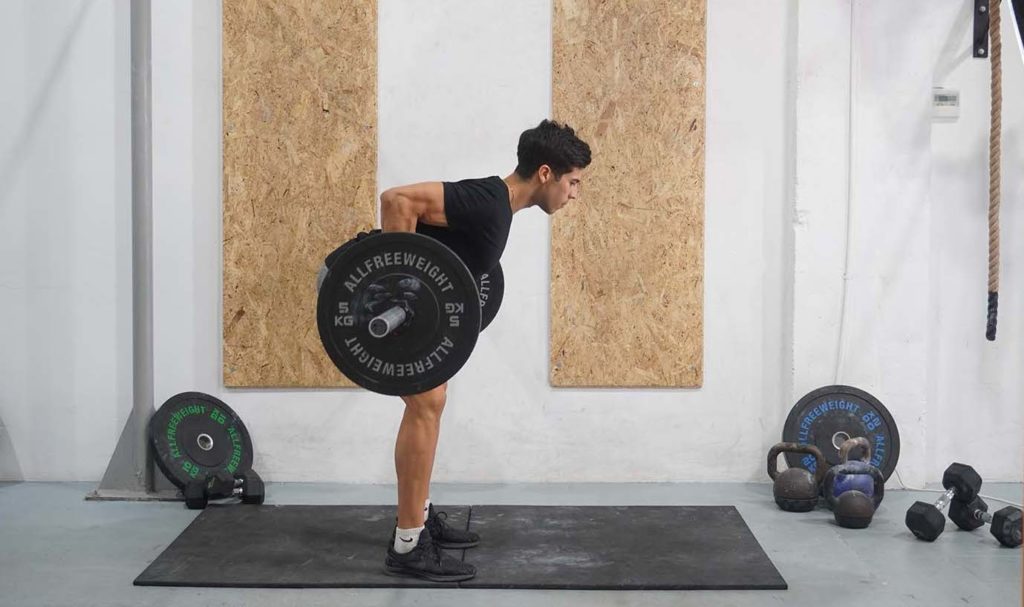

Muscle groups: Entire Back, Shoulders, Biceps, Forearms, and Abs
Equipment: Barbell and Weight Plates
Step by Step Instructions:
- Stand a few inches away from the barbell.
- Bend forward and grab the bar with an even, overhand grip. Your hands should be shoulder-width apart or slightly wider.
- Take a breath, engage your abs, and bring your shoulders as far back as you can.
- Lift the bar a couple of inches off the floor, making sure to keep your torso as parallel to the floor as you can.
- Take another breath and maintain this braced position.
- Row the barbell toward your stomach and tap it lightly.
- Hold the position for a moment and gradually lower the barbell, exhaling on the way down.
Exercise 3: Sumo Deadlift
Similar to conventional deadlifts, sumo is great for overloading the back and building it up. The primary difference is, that one seems to activate the quadriceps a bit more (7).
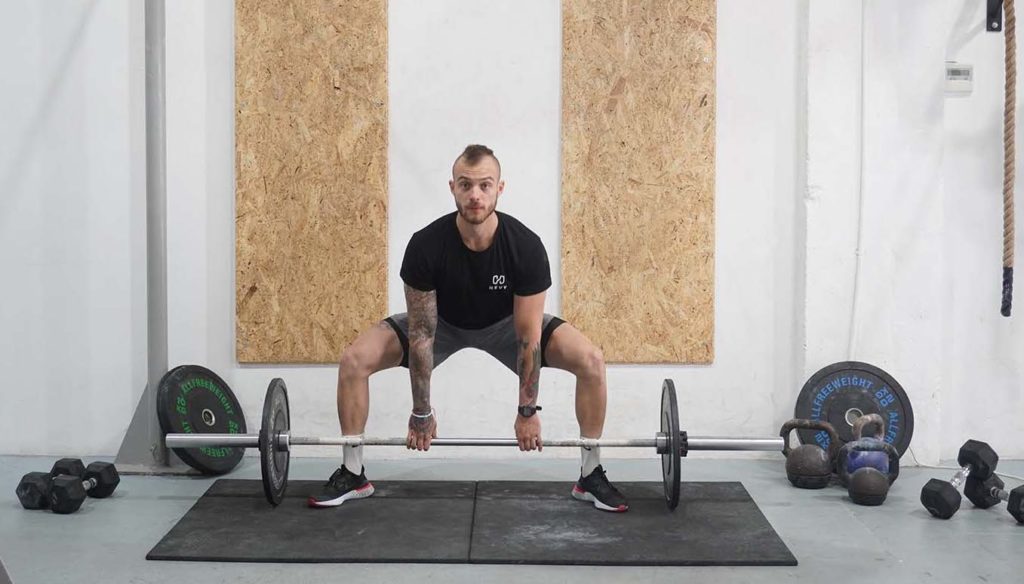

Muscle groups: Hamstrings, Quadriceps, Glutes, Entire Back, Shoulders, Chest, Biceps, Forearms, Abs, and Transverse Abdominis
Equipment: Barbell and Weight Plates
Step by Step Instructions:
- Stand a few inches away from the barbell and assume a wide stance. Spread your feet wider than your shoulders with toes pointed out.
- Similar to conventional deadlifts, your shins should be close to the barbell, and your feet should be underneath it.
- Bend at the knees while keeping your back straight and grab the barbell with an even, overhand grip. Your hands should be relatively close – shoulder-width apart or slightly closer.
- Take a breath, engage your abs, and drive your hips down and forward. This maneuver will place your shins against the barbell, put you in a tight position, and pull the slack off the bar. Make sure your shoulders are back and your lower back is neutral.
- Take another breath, drive your heels into the floor, and pull the bar in a straight line up.
- As you’re near the top, drive your hips forward to lock the repetition out and hold for a second.
- Release the barbell carefully and guide it in a straight line down as you exhale.
Exercise 4: Pendlay Row
Similar to bent-over rows, the Pendlay row is also great for back development. Only here, you get to rest the barbell on the floor between repetitions.
Muscle groups: Entire Back, Shoulders, Biceps, Forearms, and Abs
Equipment: Barbell and Weight Plates
Step by Step Instructions:
- Stand a few inches away from the bar with your feet close and toes pointed slightly out.
- Bend forward and grab the bar with an even, overhand grip. Have your hands shoulder-width apart.
- Bend your knees slightly, have your feet planted firmly, and bring your shoulders back to straighten your spine.
- Breathe in and row the barbell from the floor, tapping your stomach lightly.
- Release the barbell, exhale on the way down, and rest it on the floor again.
Exercise 5: Rack/Block Pull Deadlifts
Similar to deadlifts the rack/block pull deadlifts are a variation that is also excellent for the back. But since you’ve elevated the barbell, your lower body doesn’t work as much, and it’s mostly your back doing the work.


Muscle groups: Glutes, Entire Back, Shoulders, Chest, Biceps, Forearms, Abs, and Transverse Abdominis
Equipment: Barbell, Weight Plates, and a squat rack or blocks to elevate the bar
Step by Step Instructions:
- Elevate the barbell to just above your knees.
- Approach it, set yourself up as you would for any other deadlift, and bend forward to grab the barbell. Your hands should be shoulder-width apart.
- Bend your knees slightly, bring your shoulders back, engage your abs, and take a breath.
- Pull the barbell up in a straight line, extending your hips forward at the top of the repetition.
- Lower the barbell in the same straight line, exhaling on the way down.
Exercise 6: Seal Rows
Seal rows are an excellent chest-supported exercise that allows you to overload your back with lots of weight and reduce the risk of technique breakdown.
Muscle groups: Entire Back, Glutes, Shoulders, Biceps, Forearms, and Abs
Equipment: Barbell, Weight Plates, Flat Gym Bench, and plates or other objects to elevate the bench
Step by Step Instructions:
- Elevate a gym bench on bumper plates or something similar and equally as sturdy. The goal is to fully extend your arms as you lie face down and let them hang down.
- Position the barbell underneath the bench and set yourself up by lying on the bench over it.
- Reach down and grab the barbell with an even overhand grip. Have your hands shoulder-width apart.
- Bring your shoulders as far back as you can, engage your abs, and squeeze your glutes.
- Take a breath and row the barbell up, tapping the underside of the bench before lowering it to the floor and exhaling.
Exercise 7: Goodmorning
Though not strictly a back exercise, the goodmorning is fantastic for training the entire posterior chain – everything from your hamstrings up to your neck (8).
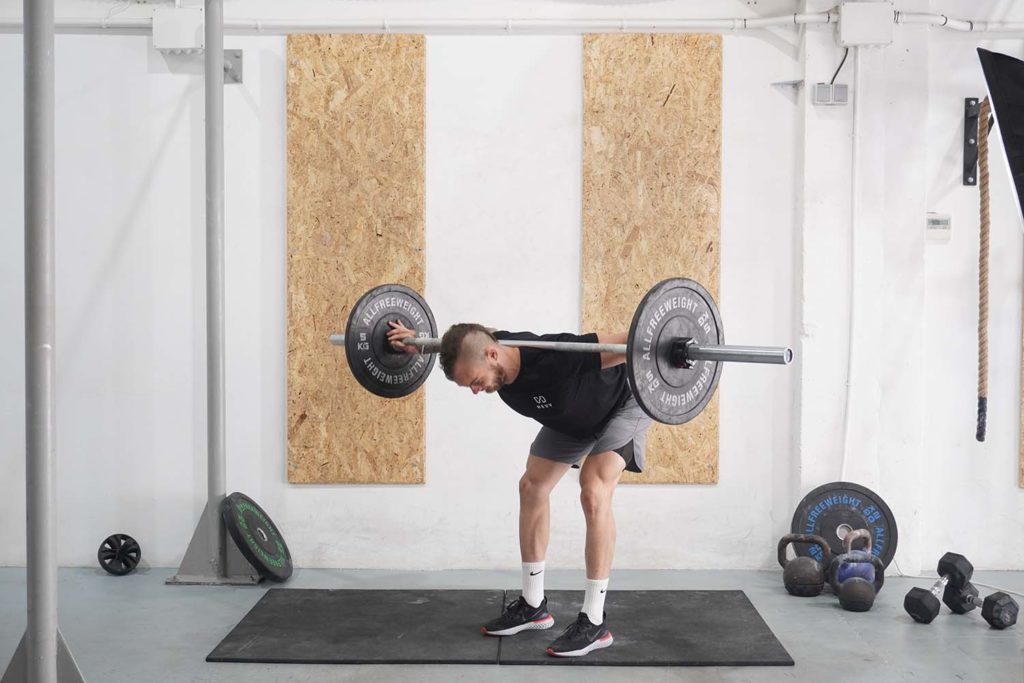

Muscle groups: Hamstrings, Glutes, Entire Back, Shoulders, Chest, Biceps, Forearms, Abs, and Transverse Abdominis
Equipment: Barbell, Weight Plates, and Squat Rack
Step by Step Instructions:
- Set a barbell at collarbone height.
- Place your hands over the bar and spread them slightly wider than your shoulder width.
- Tuck underneath the barbell and place your upper back into it. Position your lower trap area against the bar, similar to how you would set up for a low-bar back squat.
- With your feet underneath the barbell, extend your knees to unrack the barbell, and take a couple of steps back to make enough room.
- Have your feet hip-width apart with toes pointed slightly out and knees bent just a bit.
- Engage your abs, squeeze your glutes, and take a breath.
- Simultaneously bring your butt back as you bend your torso forward, making sure to keep your back neutral.
- Lower your torso until you feel a nice stretch in the back of your legs and hold for a moment.
- Raise the barbell by bringing your hips forward and simultaneously driving your back into the barbell.
- Exhale near the top.
Exercise 8: Meadows Row
The Meadows row is slightly unusual, but it works incredibly well for building upper back thickness.
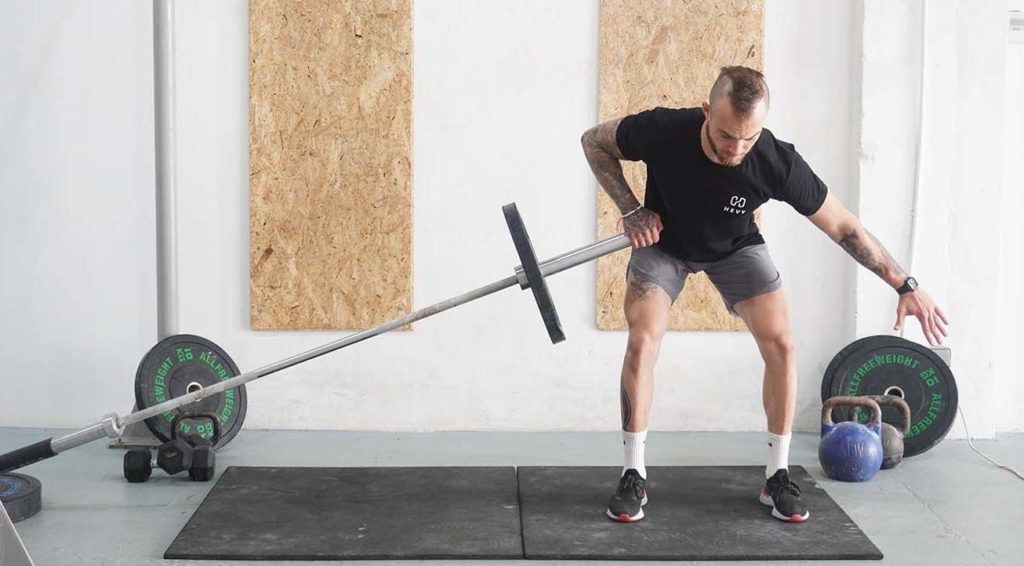

Muscle groups: Entire Back, Shoulders, Biceps, Forearms, Abs, and Obliques
Equipment: Barbell, Weight Plates, and Barbell Anchor or Landmine Attachment
Step by Step Instructions:
- Place one side of the barbell in a landmine attachment and add a weight plate or two on the other end.
- Stand sideways to the side of the barbell with the weight plates on it.
- Bend down and grab the end of the barbell with an overhand grip.
- Stagger your stance, bend your knees, bring your shoulders back, and place your free arm over the knee. These steps will put you in a safe and strong position.
- Lift the barbell just off the ground, and don’t rest it on the floor until you finish the set.
- Take a breath and pull the barbell up until your elbow is at torso level.
- Lower the barbell, making sure to extend your arm, exhaling on the way down.
- Once finished, rotate, grab the bar with the other hand, and repeat for the same number of repetitions.
Exercise 9: Barbell Shrugs
Barbell shrugs are a fantastic exercise for overloading your trapezius with a lot of weight and strengthening your grip.
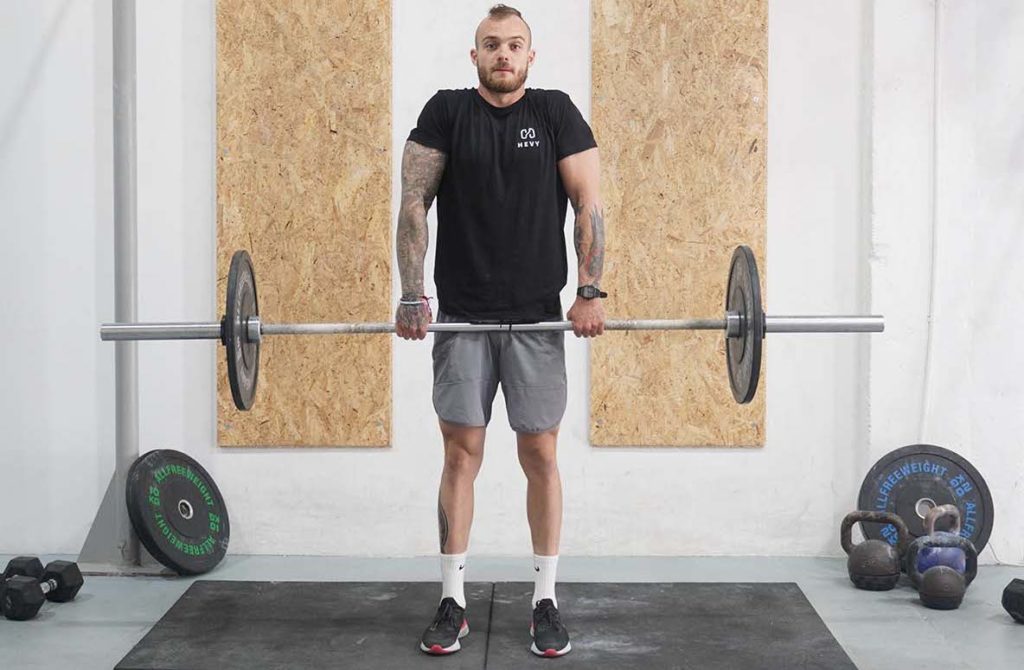

Muscle groups: Entire Back, Shoulders, Biceps, Forearms, and Abs
Equipment: Barbell and Weight Plates
Step by Step Instructions:
- Grab the barbell with an even overhand grip. Your hands can be roughly shoulder-width apart or slightly wider.
- Lift the barbell off the floor.
- Bring your shoulders back, engage your abs, and squeeze your glutes. Also, make sure to keep your arms straight.
- Take a breath and shrug the barbell up, driving the motion through your upper back muscles. If it helps, imagine that you’re trying to touch your ears with your traps. While impossible, this cue could help you shrug higher.
- Hold the top position and release the barbell for a moment, allowing your shoulders to drop as you exhale.
Conclusion
Your back is home to some of the most important muscle groups in your entire body. If you’re interested in raw strength, power, and athleticism, strengthening your back should be near the top of your to-do list. Barbells are a fantastic option for back training because they allow for a quick and efficient workout. Instead of doing a range of movements, you can build your entire back with just a few core lifts. Plus, the overloading potential is excellent, and you can choose from many great movements.
A good barbell back workout will rarely need more than two to three movements. The primary reason is, barbell training is intense and draining, so you should control your training volume and avoid doing too much in a single session. No matter how you look at it, barbell back training is fun, challenging, and incredibly effective for building lots of muscle mass and strength.
Create and plan your back workouts in advance with Hevy.





Hevy – Workout Tracker





Hevy – Workout Tracker
Create your own dumbbell back workout with Hevy, and track your progress – for free
Frequently asked questions
Why use a barbell instead of dumbbells? Are they better?
Barbells are not inherently better than dumbbells for back workouts – they simply offer a unique set of benefits. Most notably, you should use them because you can do great compound movements, go through movements quicker, and involve more of your muscles.
When using a barbell, do I include the bar’s weight when adding up the weight I am lifting?
Yes. For instance, if the bar weighs 45 lbs and you add a couple of 45-pound plates, count 135 lbs, not 90.
How do I do a hook grip?
Using a hook grip is relatively simple but uncomfortable. As you grab the barbell, first position your thumb into it and then envelop it with your other fingers. When you lift the weight, the load will drive your fingers into the thumb, resulting in a more secure grip.


